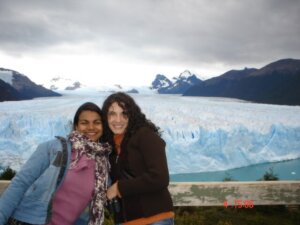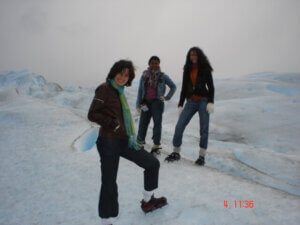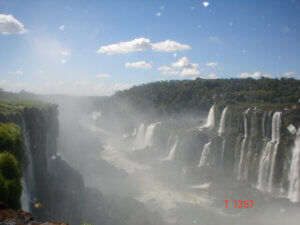On our trip to Argentina, we had already talked about Buenos Aires, its exciting capital city.
Now it is the turn of two of the great attractions of this kind South American nation that represents its extremes: to the north, the Iguazú Falls and to the south, Patagonia.
Join us!
The Calafate

Our gateway to Patagonia was the town of El Calafate. To get to this beautiful Patagonian town we take a 3-hour flight from Buenos Aires. There is the cheapest option of the bus, but the trip is about 36 hours.
The flight suffered a lot of turbulence. Perhaps caused by the Antarctic air masses that by these latitudes collide with the temperate masses of South America. The airport that serves El Calafate and the entire surrounding region is located about 17 kilometers from the town center.
Our first impression of El Calafate was really positive: a welcoming town in the middle of endless Patagonia and surrounded by high mountains, magnificent glaciers and turquoise lakes. We arrived in February, leaving the southern summer. It was a little cold, but nothing unpleasant.
The view of El Calafate is reminiscent of alpine villages: chalets made of wood surrounded by snow-capped peaks. These wooden constructions, which conserve heat, are seen both in residential constructions and in public buildings and lodgings.
The city serves as a cultural and tourist center for the entire region. From there, tour operators leave for the Perito Moreno Glacier, the Fitz Roy peak, the lakes, etc.
It is worth visiting the
Glaciarum, a museum of modern architecture dedicated to the knowledge of glaciers. It even has an ice bar!
In El Calafate you absolutely must try the ice creams and jams. They are the best we have tasted in all our travels.
Perito Moreno Glacier

One of the most impressive tourist attractions in Patagonia is the Perito Moreno Glacier. It is a glacier between Chile and Argentina. It is named as a tribute to the Argentine scientist and geographer
Francisco Moreno, called “Perito Moreno”, who contributed to making the division between the two countries.
To access this national park from El there are three options: take a bus, rent a car or hire a tour. We took a tour, at a price of 170 USD each.
From El Calafate to the glacier it is more or less an hour by road.
The only tour operator authorized to organize tours to the glacier is “
Hielo y Aventura“. There are other agencies that offer the tour, but always through this authorized operator. To save commissions, it is better to contract directly with them.
The tour to Perito Moreno included a hike on the glacier. The trekking is with the appropriate equipment, all included in the price of the tour. You cannot enter the glacier alone. If you want to know it, it must be with guides.
Also included in the tour is a catamaran ride across the lake to the glacier.

The tour does not include food, you have to bring it. It is better that it be something light to enjoy it to the fullest.
There are three viewpoints to appreciate the glacier. From below on board the catamaran and using the gangways at two levels: the middle and above.
These walkways to see from a medium and high level are the ideal ones to appreciate the glacier in all its splendor. This tour is included in the trekking, which lasts about an hour and a half. The top of the walkways offer the best views.
The guides tell you where to walk and where to take photos. The guide prepared us a whiskey with ice from the glacier itself. Delicious.
When we went, it was the time of the glacier recession (summer) and we witnessed how part of the front wall of the glacier collapses and the lake falls. The noise was awesome.
We recommend bringing cash to visit the Perito Moreno and the Patagonian national parks. Wear warm clothes. There is no exchange house, you have to take Argentine currency.
Iguazu waterfalls

On the other side, to the north of Argentina are the powerful Iguazú Falls.
If you plan to go to Argentina, it is almost a must to go to Iguazú.
It is the largest waterfall in the world, very close to the triple border of Argentina, Brazil and Paraguay, it can be seen from Argentina and Brazil.
There are three circuits:
A circuit allows you to see the falls from above, from platforms.
A second circuit from the lake itself by boat allows you to see the waterfall from the bottom up.
The third circuit goes through the so-called Devil’s Throat, a narrow and long abyss where half of the Iguazú river falls and is where the Argentina-Brazil border runs.
For Iguazú you must bring a raincoat, because when you cross the panoramic bridge you will come out completely wet.
The falls are 2,700 meters wide, of which 600 are from Brazil and the remaining 2,100 meters are on the Argentine side. If one accesses from the Brazilian side, the views of the waterfalls are more panoramic, and from the Argentine side the experience is more immersive. The falls present their most impressive views between March and May, when their flow is highest.
A tour that will remain for a future visit is to go by car from Argentina to Brazil.
Conclusions
 Argentina is a huge country and, although for the world Argentine culture is only tango and gauchos, the truth is that it is a country of many contrasts.
Argentina is a huge country and, although for the world Argentine culture is only tango and gauchos, the truth is that it is a country of many contrasts.
From the semi-tropical jungles of Misiones, with its impressive waterfalls reminiscent of the Amazon, to its glaciers that approach Antarctica. And from the high Andean mountains and their piedmont wine regions to the pampas, so similar in their ecosystem and culture to the Colombian-Venezuelan plains, each region of this beautiful country presents a unique character.
A single trip is not enough to know everything that Argentina can offer, but if you want a representative summary of this country, the Iguazú-Buenos Aires-Mendoza-Patagonia circuit is one of the best options.
 Our gateway to Patagonia was the town of El Calafate. To get to this beautiful Patagonian town we take a 3-hour flight from Buenos Aires. There is the cheapest option of the bus, but the trip is about 36 hours.
Our gateway to Patagonia was the town of El Calafate. To get to this beautiful Patagonian town we take a 3-hour flight from Buenos Aires. There is the cheapest option of the bus, but the trip is about 36 hours. One of the most impressive tourist attractions in Patagonia is the Perito Moreno Glacier. It is a glacier between Chile and Argentina. It is named as a tribute to the Argentine scientist and geographer Francisco Moreno, called “Perito Moreno”, who contributed to making the division between the two countries.
One of the most impressive tourist attractions in Patagonia is the Perito Moreno Glacier. It is a glacier between Chile and Argentina. It is named as a tribute to the Argentine scientist and geographer Francisco Moreno, called “Perito Moreno”, who contributed to making the division between the two countries. The tour does not include food, you have to bring it. It is better that it be something light to enjoy it to the fullest.
The tour does not include food, you have to bring it. It is better that it be something light to enjoy it to the fullest. On the other side, to the north of Argentina are the powerful Iguazú Falls.
On the other side, to the north of Argentina are the powerful Iguazú Falls. Argentina is a huge country and, although for the world Argentine culture is only tango and gauchos, the truth is that it is a country of many contrasts.
Argentina is a huge country and, although for the world Argentine culture is only tango and gauchos, the truth is that it is a country of many contrasts.